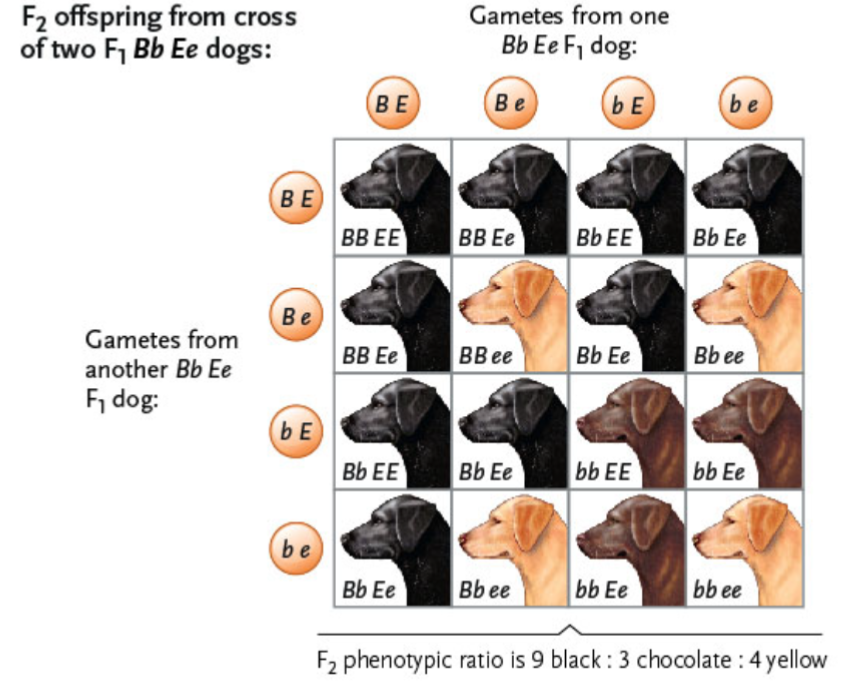Biol 214 - Mendel, Genes, and Inheritance
1/24
Earn XP
Description and Tags
For Exam 3. Use Punnett squares to predict offspring ratios; explain how meiosis, crossing over, and recombination lead to genetic variation; and describing how genes are passed from parents to offspring.
Name | Mastery | Learn | Test | Matching | Spaced |
|---|
No study sessions yet.
25 Terms
Gene
A segment of DNA that codes for a specific trait.
Allele
A specific variant or version of a gene. A pair of alleles, no more and no less, govern the inheritance of each trait.
Mendel’s Principle of Segregation
The idea that pairs of alleles controlling a character segregate as gametes are formed; half the gametes carry one allele, and the other half carry the other allele.
First Filial (F₁) Generation
The first generation of offspring resulting from a P generation cross.
Second Filial (F₂) Generation
The second generation of offspring resulting from an F₁ generation cross.
Monohybrid
A heterozygous individual for a specific gene.
Dihybrid
An individual heterozygous for two genes.
Monohybrid Cross
A genetic experiment that studies the inheritance of a single trait by crossing two parent organisms that are heterozygous for the same pairs of alleles.
Produces a 3:1 ratio.
Dihybrid Cross
A genetic cross where two parents, each heterozygous for two different traits, are bred to observe the inheritance of both traits simultaneously and follow Mendel’s Principle of Independent Assortment.
Produces a 9:3:3:1 ratio.
Mendel’s Principle of Independent Assortment
The alleles for one trait does not influence the probability of the other. Traits of different characters were distributed to offspring independently, not inherited together.
Test Cross
A genetic cross between a homozygous recessive individual with a dominant trait and an unknown genotype. Often used to determine the genotype of an organism that shows a dominant phenotype but has an unknown genotype.
If half of the offspring have the dominant trait and half have the recessive trait, then the tested individual must be a heterozygote.
If all offspring have the dominant trait, the tested individual must be a homozygote.
Parental (P) Generation
The initial set of parents in a genetic cross.
The Product Rule in Probability
When two or more events are independent, we calculate the probability that they will occur in succession using the product rule (multiply their individual probabilities).
The Sum Rule in Probability
When there are two or more different ways of obtaining the same outcome, we determine the probability using the sum rule (add the individual probabilities).
Sutton’s Chromosome Theory of Inheritance
The idea that genes and their alleles are carried on the chromosomes.
Evidence: separation of a chromosome pair in meiosis and gamete formation is independent of the separation of other pairs, similarly to alleles. One member of each chromosome pair is derived from the male parent, and one from the female parent, similarly to alleles.
Locus
The particular site on a chromosome at which a gene is located. More specifically, it is a particular DNA sequence that typically encodes a protein responsible for the phenotype controlled by the gene.
Incomplete Dominance
When one allele of a gene is not completely dominant over another allele of the same gene. The phenotype of the heterozygote is intermediate between the phenotypes of the dominant and recessive homozygotes.
In a monohybrid cross, the phenotypes of F 2 individuals are seen in a 1:2:1 ratio.
Ex. flower color in snapdragons and normal x bully in Whippets
Codominance
When the effects of two alleles of a gene are equally detectable in heterozygotes.
Ex. human MN blood group.
Multiple Alleles of a Gene
Although an individual can carry only two alleles for a gene, multiple alleles (more than two different alleles of a gene) may be present in the population as a whole.
Multiple alleles of a gene each contain differences at one or more points in their DNA sequences.
How are the human A-B-O blood groups an example of multiple alleles, dominance, and codominance in the same system?
Codominance: I^A and I^B
Recessive: i
The four blood types – A, B, AB, and O – are produced by different combinations of multiple (three) alleles of a single gene.
Epistasis
When an interaction of two genes results in alleles of a gene at one locus inhibiting (masking) the effects of alleles of a different gene at a different locus.
The result of epistasis is that some expected phenotypes do not appear among offspring. Recessive epistasis occurs when a recessive homozygous genotype at one locus masks the expression of alleles at another locus, while dominant epistasis occurs when a dominant allele at one locus masks the expression of alleles at another locus.
Recessive epistasis ex: black (BB or Bb with EE or Ee), chocolate (bb with EE or e), or epistatic golden (BBee,Bbee, bbee) retrievers.
Results in a 9:3:4 ratio.

Polygenic Inheritance
When several to many different genes contribute to the same character (quantitative traits), which are often influenced by the environment.
Quantitive Trait
A trait that shows a range of variation (a continuum) rather than falling into just a few categories.
Ex: human height and skin color.
Quantitative Trait Loci (QTLs)
The part of the genome that influences a quantitative trait.
Pleiotropy
Where a single gene affects more than one character of an organism.
Ex. sickle-cell anemia, which changes a single structure (hemoglobin) but can inflict wide-ranging pleiotropic effects that damages many tissues and organs in the body and affects many body functions.